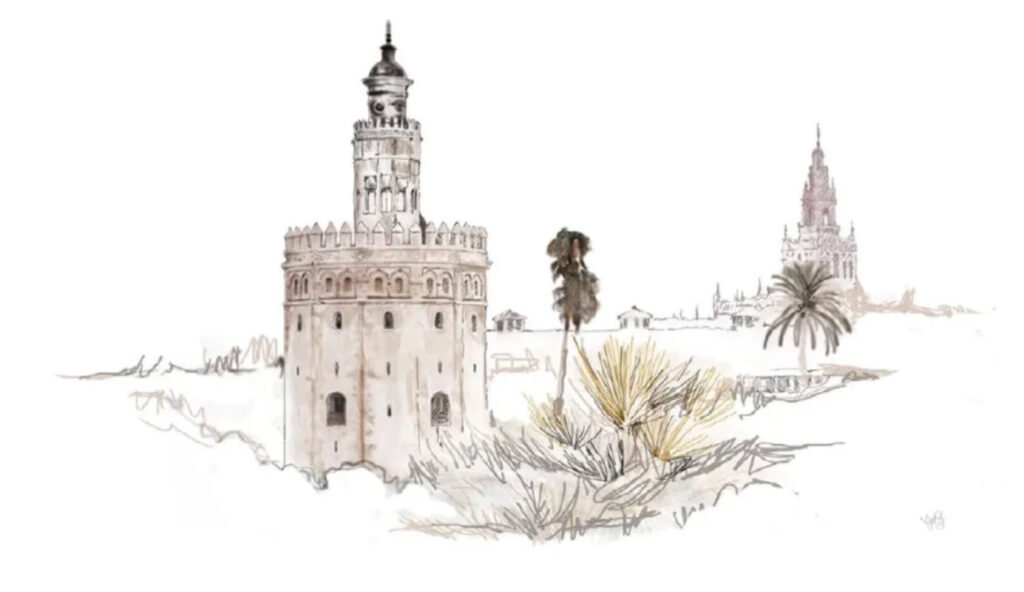Portada » Initiatives » Training » Summer School » Previous editions » Seville
Seville

The Summer School was organized by the Premio Rafael Manzano and the School of Architecture of the University of Notre Dame, thanks to the support of the Richard H. Driehaus Charitable Lead Trust and the collaboration of the Universidad Alfonso X el Sabio, the Universidad de Sevilla, the Universidad de Alcalá, the Universidad de Miami, the Real Academia de Bellas Artes de Santa Isabel de Hungría, the Real Academia Sevillana de Buenas Letras, the Fundación Medinaceli, INTBAU Spain and the Centro de Investigación de Arquitectura Tradicional (CIAT).
This area was for centuries a significant milestone in the Sevillian landscape, which is today a very shafted place. Its environment has gradually gone degenerating as unfortunate urban interventions have been happening around it. With the demolition of a good part of the complex Cruzcampo, there are two alternatives: to try to reverse this process or to continue opening old wounds.
In 2006, the news announced the architects Norman Foster, Jean Nouvel, Arata Isozaki and Vázquez Consuegra were preparing together a project for this zone that was including 1.963 housings piled up in between 14 – 16 storey buildings. This foreshadowed the worst of the possible outcomes. Recently the Urban Planning Department has gone back to the idea of reordering this zone, publishing a new Special Plan of Interior Reform (PERI) which the housings will stacked in not more pleasing linear blocks of 9 floors.
This type of urban designs, removed from the traditional beauty, the comfort and the inherent sustainability of the architecture and the urbanism of the city of Seville, are unfortunately those which for decades dominate both the profession and the education of the Architecture and Urbanism.
During these weeks, the participants in the Seville Summer School have worked stubborn on analyzing the squares, streets, houses and patios more attractive, measuring, drawing and photographing each.
All this has been processed at the headquarters of the institution that generously hosted them: The Real Academia Sevillana de Buenas Letras. Thus, they could have taken as a reference the most beautiful and lasting spaces of Seville to the reorganization of the damaged area of the Cruz del Campo, proposing an alternative urban expansion that could illuminate the possible way ahead in the projected development of this area.
The studio work was enhanced with a series of short lectures given by some professionals or researches on the urban history of Seville, architectural and construction traditions, and issues dealing to the conservation of the landscape identity of downtown Seville.
The faculty that accompanied the development of the proposal was Alejandro García Hermida, Frank Martínez, Lucien Steil and Samir Younés.
The invited lectures were: Rafael Manzano Martos, Vicente Lleó, José Peral, Fernando Quiles, Andrés Joaquín Egea, Luis Fernando Gómez-Stern y Mª Cruz Aguilar.
Participants, coming from seven different countries, were: Samira Albiac, Javier Ballesteros, Pablo Bañasco, Callie Beal, Gaétane Borne, Elizabeth Connaughton, Paula García, Rafael Gómez, Alexandria Gordon, Taryn Gutiérrez, Silvia Huelves, Zeynep Iqbal, Valérie Julien, Nirui Kang, Samie Kayani, Patrick Keough, Abner Samuel Lima González, Ruth López Calzada, Gonzalo Luengo, Michael Madsen, Eduardo Mascagni, Rafael Moreno, Esteban Orellana, Mª Angeles Sainz de Rozas, Miguel Segovia, Eric Stalheim, Isabela Tiñana Díaz, Margherita Tommassi, Mary Catherine Walter and Yueting Zhang.
And many others collaborated supporting us in different ways, including Julia Manzano, Rafael Valencia, Antonio Collantes, Antonio Gámiz, Fernando, Rebeca Gómez-Gordo, Kathy Rodgers, Luna Medina, Harriet Wennberg and Carol Wyant.
A priority design aim was to provide vitality and beauty to the public space. Therefore, the areas were distributed around 6 squares. Each team was assigned to work in one on implementing what had been previously covered in visits and conferences.
Buildings with different uses were proposed, avoiding the tendency to zoning that it makes the inhabitants of the cities slaves of the car. Emphasis was placed on the control of dimensions and character of public spaces: street sections, the number of floors, the size of the blocks, etc. As for the materialization of the proposed volumes and spaces, it was sought going ahead with the architectural heritage of the city.
It was presented a new model of city for the 21st century which not renounces the best legacy of the local architectural tradition, but, growing and learning from the same one, looking enrich it adapting to the requirements of our time. A neighborhood where to provide with vitality and beauty to its streets and squares is a priority in the design, where people do not depend on the car in their daily lives, where the public does not become segregated in monotonous apartment blocks according to their different power purchasing.
To complete the work, they started with a hypothetical Management Plan, on which there would be necessary to try to incorporate everything learned. Divided into six groups, each in charge of one of the proposed sectors, participants and teachers had the opportunity to exchange ideas and work together in the development of the proposal.
In the design process, it was emphasized in the use of watercolors, pencils, rulers, compasses, scales, … resorting to techniques with which students and professional architects become increasingly less familiar, having been forgotten importance of freehand drawing when to assimilate and design spaces and architectural elements with the scale and the correct proportions.